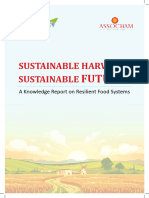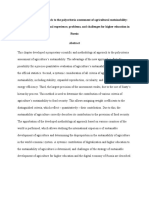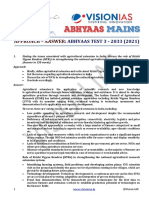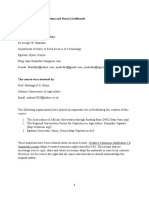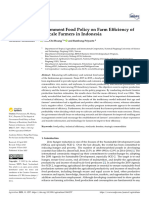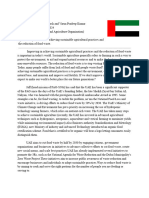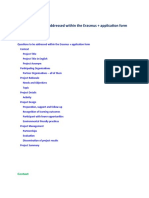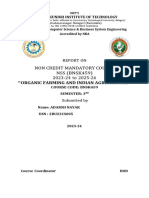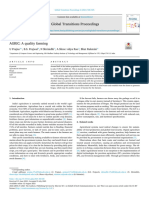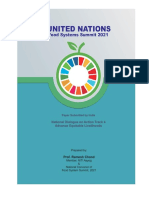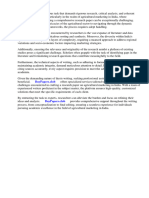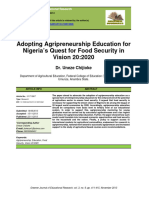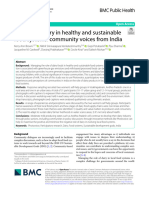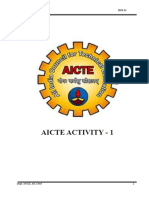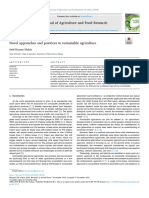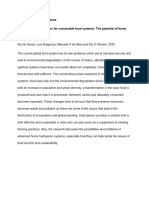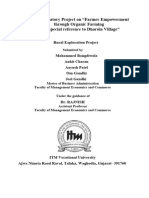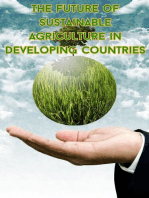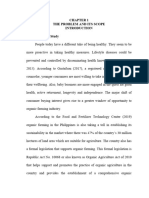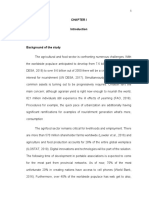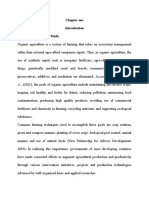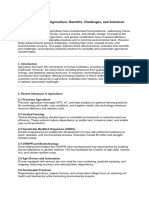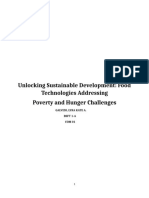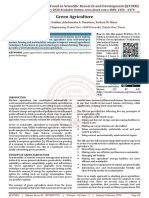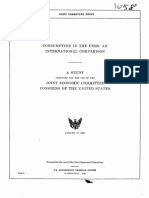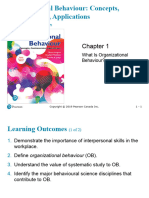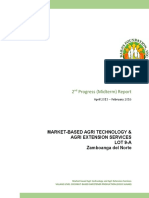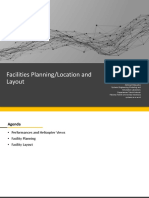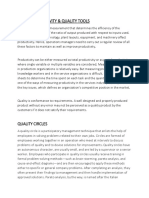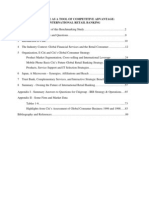1267-Article Text-2768-1-10-20240705
1267-Article Text-2768-1-10-20240705
Uploaded by
revamonte01Copyright:
Available Formats
1267-Article Text-2768-1-10-20240705
1267-Article Text-2768-1-10-20240705
Uploaded by
revamonte01Copyright
Available Formats
Share this document
Did you find this document useful?
Is this content inappropriate?
Copyright:
Available Formats
1267-Article Text-2768-1-10-20240705
1267-Article Text-2768-1-10-20240705
Uploaded by
revamonte01Copyright:
Available Formats
International Journal of Applied Research in Social Sciences, Volume 6, Issue 7, July 2024
OPEN ACCESS
International Journal of Applied Research in Social Sciences
P-ISSN: 2706-9176, E-ISSN: 2706-9184
Volume 6, Issue 7, P.No. 1297-1309, July 2024
DOI: 10.51594/ijarss.v6i7.1267
Fair East Publishers
Journal Homepage: www.fepbl.com/index.php/ijarss
Improving agricultural practices and productivity through
extension services and innovative training programs
Eyitayo Raji1, Tochukwu Ignatius Ijomah2, & Osemeike Gloria Eyieyien3
1
Independent Researcher, Chicago, USA
2
Independent Researcher, Australia
3
FDM, UK
______________________________________________________________________________
Corresponding Author: Eyitayo Raji
Corresponding Author Email: eyitayo.raji@gmail.com
Article Received: 15-01-24 Accepted: 25-04-24 Published: 06-07-24
Licensing Details: Author retains the right of this article. The article is distributed under the terms of the
Creative Commons Attribution-Non Commercial 4.0 License
(http://www.creativecommons.org/licences/by-nc/4.0/) which permits non-commercial use, reproduction
and distribution of the work without further permission provided the original work is attributed as
specified on the Journal open access page.
______________________________________________________________________________
ABSTRACT
Agricultural productivity is fundamental to global food security and economic development. This
paper explores the critical role of extension services and innovative training programs in
enhancing agricultural practices and productivity. Traditional farming methods, while
sustainable, often fail to meet the demands of modern agriculture due to limited efficiency and
vulnerability to environmental changes. Extension services bridge the gap between research and
practical application, offering advisory services, training, information dissemination, and
resource facilitation. Innovative training programs provide farmers with essential knowledge and
skills, including workshops, on-field training, and digital platforms. These initiatives lead to
significant productivity improvements, evidenced by success stories like the Farmer Field
Schools and India's e-Extension program. Comparative analyses show that regions with robust
extension services and training programs report higher productivity and resilience. Scaling up
these successful models, integrating modern technologies, fostering public-private partnerships,
Raji, Ijomah, & Eyieyien, P.No. 1297-1309 Page 1297
International Journal of Applied Research in Social Sciences, Volume 6, Issue 7, July 2024
and building local capacity are recommended to further enhance their impact. Ultimately, these
efforts are vital for sustainable agricultural development and food security.
Keywords: Agricultural Productivity, Extension Services, Innovative Training Programs,
Sustainable Agriculture, Food Security.
_____________________________________________________________________________
INTRODUCTION
Agricultural productivity is critical to global food security, economic development, and poverty
alleviation. As the world's population continues to grow, the demand for food increases,
necessitating more efficient and sustainable agricultural practices (Mozumdar, 2012). The ability
to produce sufficient food to meet this demand is fundamental for feeding populations and
maintaining the livelihoods of millions of farmers worldwide. Improvements in agricultural
productivity can lead to increased incomes for farmers, enhanced food security, and overall
economic growth, particularly in developing countries where agriculture often forms the
backbone of the economy (Bhattacharyya, Patil, Bhave, & Haldankar, 2018).
Despite the importance of high agricultural productivity, farmers face numerous challenges that
hinder their ability to improve practices and yields. These challenges include limited access to
modern farming technologies, insufficient knowledge of advanced agricultural techniques, poor
infrastructure, and inadequate financial resources. Additionally, climate change poses a
significant threat, introducing unpredictable weather patterns and increasing the frequency of
extreme events such as droughts and floods. These factors collectively contribute to the difficulty
farmers experience in enhancing their productivity and achieving sustainable agricultural
practices.
Extension services and innovative training programs are pivotal in addressing these challenges.
Agricultural extension services are designed to provide farmers with the knowledge and tools
they need to adopt new and improved farming practices. These services include disseminating
information on crop management, pest control, soil health, and irrigation techniques. By bridging
the gap between research institutions and the farming community, extension services ensure that
farmers can access and apply the latest advancements in agricultural science (Bhattacharyya et
al., 2018; Waddington et al., 2014).
Innovative training programs complement extension services by offering practical, hands-on
education tailored to the specific needs of farmers. These programs can take various forms,
including on-field training sessions, workshops, and digital learning platforms. By utilizing
modern technologies such as mobile applications and online courses, training programs can
reach a broader audience and provide continuous support to farmers. This combination of
personalized instruction and technological integration helps farmers overcome barriers to
learning and adopt new practices more effectively.
This paper aims to explore how agricultural extension services and innovative training programs
can improve agricultural practices and productivity. By examining the current state of
agricultural practices, the role of extension services, and the impact of training programs, this
paper aims to highlight the significance of these interventions in transforming agriculture. It will
also discuss the measurable impacts on productivity and provide recommendations for scaling up
these initiatives to benefit a larger number of farmers. Ultimately, this paper seeks to contribute
Raji, Ijomah, & Eyieyien, P.No. 1297-1309 Page 1298
International Journal of Applied Research in Social Sciences, Volume 6, Issue 7, July 2024
to the ongoing efforts to enhance global agricultural productivity, ensuring food security and
sustainable development for future generations.
Current State of Agricultural Practices
Agricultural practices have evolved significantly over millennia, yet many farmers worldwide
rely on traditional methods passed down through generations. These traditional agricultural
practices are often characterized by their reliance on manual labor, simple tools, and indigenous
crop management knowledge. While these methods have sustained communities for centuries,
they are increasingly inadequate in meeting the demands of modern agriculture, which requires
higher productivity and sustainability to feed a growing global population (Animashaun,
Familoni, & Onyebuchi, 2024a; Oduro, Simpa, & Ekechukwu, 2024a).
Overview of Traditional Agricultural Practices
Traditional agricultural practices vary widely across regions, reflecting local environmental
conditions, cultural heritage, and available resources. Common methods include crop rotation,
intercropping, and using organic fertilizers such as manure and compost. Farmers often select
crops based on their adaptability to local soils and climates, employing techniques such as
terracing and contour ploughing to manage water and soil erosion. Livestock is typically
integrated into farming systems, providing a source of manure for fertilization and serving as a
critical component of mixed farming practices (Esiri, Babayeju, & Ekemezie, 2024; Scott,
Amajuoyi, & Adeusi, 2024a).
While sustainable and ecologically sound, these methods often lack the efficiency and scalability
required to meet current agricultural demands. Traditional practices are labor-intensive and time-
consuming, and yields are frequently lower than modern agricultural techniques. Additionally,
the reliance on natural cycles and local inputs can make these systems vulnerable to
environmental changes and fluctuations (Udeh, Amajuoyi, Adeusi, & Scott, 2024a).
Common Issues and Limitations in Current Practices
One of the primary issues with traditional agricultural practices is their limited capacity to
increase productivity. With the global population expected to reach 9.7 billion by 2050, there is
an urgent need to produce more food on the same or even less land. With their lower yields,
traditional practices cannot keep pace with this growing demand. Furthermore, these methods
often do not incorporate advancements in agricultural science and technology, such as improved
seed varieties, synthetic fertilizers, and precision farming techniques, which have been proven to
enhance productivity (Adanma & Ogunbiyi, 2024a; Esiri, Sofoluwe, & Ukato, 2024a).
Another significant limitation is the susceptibility of traditional practices to environmental
stressors. Climate change has introduced new challenges for farmers, including more frequent
and severe weather events, shifts in growing seasons, and increased pest and disease pressures.
Traditional methods, which depend heavily on predictable weather patterns and stable
environmental conditions, are often ill-equipped to adapt to these changes. This vulnerability can
lead to crop failures, reduced yields, and increased food insecurity (Kupa, Adanma, Ogunbiyi, &
Solomon, 2024a; Udeh, Amajuoyi, Adeusi, & Scott, 2024b). Moreover, traditional agricultural
practices are often constrained by inadequate access to resources. Many smallholder farmers in
developing countries face barriers such as limited access to credit, lack of modern farming
equipment, and insufficient extension services. These farmers struggle to implement more
Raji, Ijomah, & Eyieyien, P.No. 1297-1309 Page 1299
International Journal of Applied Research in Social Sciences, Volume 6, Issue 7, July 2024
efficient and productive practices without the necessary resources and support. Additionally,
land tenure insecurity and fragmented landholdings can further hinder the adoption of improved
agricultural methods (Adanma & Ogunbiyi, 2024b; Solomon, Simpa, Adenekan, & Obasi, 2024).
The Need for Improvement in Techniques and Productivity
Given these challenges, there is a pressing need to improve agricultural techniques and
productivity to ensure food security and sustainable development. Enhancing productivity
involves increasing yields, making agriculture more resilient to environmental stressors, and
reducing its ecological footprint. This requires a multifaceted approach that integrates traditional
knowledge with modern scientific advancements.
One critical area for improvement is the adoption of modern agricultural technologies. This
includes using high-yielding and drought-resistant crop varieties, precision farming tools that
optimize inputs such as water and fertilizers, and advanced pest and disease management
strategies. Farmers can achieve higher productivity by leveraging these technologies while
minimizing resource use and environmental impact. Additionally, improving access to
agricultural extension services is essential. Extension services are vital in educating farmers
about new technologies and practices, providing them with the knowledge and skills needed to
improve their productivity. These services can also facilitate access to credit, markets, and other
resources, helping farmers to overcome the barriers they face (Ekechukwu & Simpa, 2024a;
Oyeniran et al., 2024).
Innovative training programs are also crucial in this context. Training programs that offer
practical, hands-on learning experiences can empower farmers to adopt new practices and
technologies more effectively. Digital platforms and mobile applications can further enhance the
reach and impact of these programs, providing farmers with continuous support and up-to-date
information. Furthermore, policies and investments supporting sustainable agriculture are
necessary to improve productivity. Governments and development organizations should
prioritize initiatives that promote sustainable agricultural practices, such as conservation
agriculture, agroforestry, and organic farming. These practices not only enhance productivity but
also improve soil health, conserve water, and increase biodiversity, contributing to the long-term
sustainability of agriculture (Adejugbe & Adejugbe, 2019; Ekechukwu & Simpa, 2024b).
Role of Extension Services
Agricultural extension services are essential in bridging the gap between research institutions and
farmers, ensuring that the latest advancements in agricultural science and technology reach those
who need them most. These services play a crucial role in disseminating information, providing
education, and facilitating the adoption of improved farming practices, ultimately enhancing
agricultural productivity and sustainability.
Definition and Purpose of Agricultural Extension Services
Agricultural extension services are a form of non-formal education designed to improve farmers'
skills, knowledge, and practices. The primary purpose of these services is to transfer new
technologies, research findings, and innovative farming methods from research institutions to the
farming community. Extension services aim to empower farmers by providing them with the
necessary tools and information to enhance their productivity, manage resources more
effectively, and adapt to changing environmental conditions. By doing so, extension services
Raji, Ijomah, & Eyieyien, P.No. 1297-1309 Page 1300
International Journal of Applied Research in Social Sciences, Volume 6, Issue 7, July 2024
contribute to the overall development of the agricultural sector, promoting food security and
rural livelihoods (Adejugbe & Adejugbe, 2016; Ekechukwu & Simpa, 2024b).
Types of Extension Services Available
There are several types of agricultural extension services, each tailored to meet the specific needs
of farmers and address various aspects of agricultural production. Some of the most common
types include (Animashaun, Familoni, & Onyebuchi, 2024b; Esiri, Sofoluwe, & Ukato, 2024b;
Kupa, Adanma, Ogunbiyi, & Solomon, 2024b):
Advisory Services: These services provide farmers with advice and information on various
topics, such as crop management, pest control, soil health, and irrigation techniques.
Advisory services can be delivered through one-on-one consultations, group meetings, or
digital platforms.
Training and Education Programs: Extension services often organize training sessions,
workshops, and field demonstrations to educate farmers about new technologies and
practices. These programs can be conducted on-farm or at designated training centres and are
designed to provide hands-on learning experiences.
Information Dissemination: Extension services use various channels to disseminate
information to farmers, including printed materials, radio broadcasts, television programs,
and digital media. This ensures that farmers can access up-to-date information and make
informed decisions.
Facilitation Services: These services help farmers access necessary resources, such as credit,
inputs (seeds, fertilizers, pesticides), and markets. Extension agents may assist farmers in
forming cooperatives, connecting with suppliers, or negotiating better product prices.
Benefits of Extension Services to Farmers
The benefits of agricultural extension services to farmers are manifold. Firstly, extension
services enhance farmers' knowledge and skills, enabling them to adopt improved farming
practices and technologies. This leads to increased agricultural productivity, higher yields, and
better-quality produce. For instance, farmers who receive training on integrated pest
management can effectively control pests without relying on harmful chemicals, resulting in
healthier crops and reduced environmental impact (Abiona et al., 2024; Adenekan, Solomon,
Simpa, & Obasi, 2024). Secondly, extension services help farmers manage risks and
uncertainties associated with agriculture. By providing timely information on weather patterns,
disease outbreaks, and market trends, extension services enable farmers to make informed
decisions and mitigate potential losses. For example, weather forecasting services can help
farmers plan their planting and harvesting schedules more effectively, reducing the risk of crop
failure due to adverse weather conditions (Oduro, Simpa, & Ekechukwu, 2024b; Scott,
Amajuoyi, & Adeusi, 2024b). Thirdly, extension services promote sustainable agricultural
practices that conserve natural resources and protect the environment. By educating farmers on
soil conservation techniques, water management, and agroforestry, extension services contribute
to the long-term sustainability of farming systems. This ensures the continued productivity of
agricultural land and helps mitigate the impacts of climate change (Adenekan et al., 2024;
Ekechukwu & Simpa, 2024c).
Raji, Ijomah, & Eyieyien, P.No. 1297-1309 Page 1301
International Journal of Applied Research in Social Sciences, Volume 6, Issue 7, July 2024
Examples of Successful Extension Service Initiatives
Several successful extension service initiatives have demonstrated the transformative impact of
these services on agricultural productivity and rural livelihoods. One notable example is the
Farmer Field School (FFS) program, implemented in various countries, including Indonesia,
Kenya, and the Philippines. The FFS program involves groups of farmers participating in regular
field sessions where they learn through observation, experimentation, and discussion. This
participatory approach has proven effective in enhancing farmers' knowledge, skills, and
confidence, significantly improving crop yields and farming practices.
Another successful initiative is the e-Extension program in India, which leverages digital
technology to deliver extension services to farmers. The program uses mobile applications,
online platforms, and SMS services to provide farmers real-time information on weather, market
prices, and agricultural practices. By making information more accessible, the e-Extension
program has empowered farmers to make better-informed decisions and adopt new technologies
more rapidly (Aiguobarueghian, Adanma, Ogunbiyi, & Solomon, 2024a; Jambol, Babayeju, &
Esiri, 2024).
Innovative Training Programs
Training and education are pivotal in the agricultural sector, serving as the bedrock for
improving farming practices, enhancing productivity, and fostering sustainable agricultural
development. Equipping farmers with the latest knowledge and skills through innovative training
programs is essential in an era marked by rapid technological advancements and changing
environmental conditions. These programs help farmers adapt to new challenges and empower
them to capitalize on emerging opportunities, leading to more resilient and productive
agricultural systems.
Importance of Training and Education in Agriculture
The significance of training and education in agriculture cannot be overstated. Agriculture is a
complex and dynamic field that requires a deep understanding of various factors, including soil
health, pest management, crop selection, and market dynamics. Farmers may struggle to
implement best practices without adequate training, resulting in suboptimal yields and increased
vulnerability to pests, diseases, and climate change. Training and education provide farmers with
the necessary knowledge to make informed decisions, adopt innovative techniques, and improve
farm management. This, in turn, leads to increased productivity, higher incomes, and improved
food security (Agboola, Adegede, Omomule, Oyeniran, & Aina, 2024; Babayeju, Jambol, &
Esiri, 2024).
Moreover, training and education are critical for disseminating new technologies and practices.
The agricultural sector is continuously evolving, with ongoing research and development leading
to the introduction of high-yielding crop varieties, precision farming tools, and sustainable
farming methods. Training programs serve as a conduit for transferring this knowledge from
research institutions to the farming community, ensuring that farmers stay abreast of the latest
advancements and can integrate them into their practices effectively (Aiguobarueghian, Adanma,
Ogunbiyi, & Solomon, 2024b; Modupe et al., 2024).
Raji, Ijomah, & Eyieyien, P.No. 1297-1309 Page 1302
International Journal of Applied Research in Social Sciences, Volume 6, Issue 7, July 2024
Types of Training Programs
Agriculture training programs come in various forms, each designed to cater to the diverse needs
of farmers and address different aspects of agricultural production. Some of the most common
types of training programs include (Adewusi et al., 2024; Udeh, Amajuoyi, Adeusi, & Scott,
2024c, 2024d):
Workshops and Seminars: These are typically short-term programs that provide farmers with
focused training on specific topics such as pest management, irrigation techniques, or soil
fertility. Workshops and seminars often involve expert presentations, interactive discussions,
and practical demonstrations, enabling farmers to understand the subject matter
comprehensively.
On-field Training: Also known as farmer field schools, on-field training involves hands-on
learning experiences conducted directly on farms. Farmers participate in regular sessions
where they observe, experiment, and discuss various farming practices. This participatory
approach allows farmers to learn by doing, which enhances their practical skills and
confidence in applying new techniques.
Digital Platforms: With the proliferation of digital technology, online training programs have
become increasingly popular. These platforms offer a range of resources, including video
tutorials, webinars, e-books, and mobile applications, that farmers can access anytime and
anywhere. Digital platforms provide a flexible and scalable solution for training many
farmers, especially those in remote areas.
Extension Services: Extension agents provide continuous support and education to farmers
through field visits, group meetings, and individual consultations. This type of training is
ongoing and tailored to the specific needs of farmers, ensuring that they receive personalized
guidance and assistance in implementing new practices.
Innovations in Training Methodologies
Recent innovations in training methodologies have significantly enhanced the effectiveness of
agricultural training programs. One such innovation is using participatory learning approaches,
involving farmers actively in the learning process. Methods such as problem-solving exercises,
peer-to-peer learning, and experiential learning activities encourage farmers to share their
experiences, collaborate with others, and develop practical solutions to common challenges
(Ekechukwu & Simpa, 2024d).
Another innovation is integrating information and communication technology (ICT) into training
programs. Mobile applications, online courses, and virtual reality simulations provide farmers
with interactive and immersive learning experiences. For example, virtual reality can simulate
different farming scenarios, allowing farmers to practice new techniques in a risk-free
environment before applying them in the field. Additionally, mobile applications can offer real-
time advice and updates, helping farmers make timely and informed decisions (Simpa, Solomon,
Adenekan, & Obasi, 2024a). The use of data analytics and machine learning is also transforming
agricultural training. By analyzing large datasets on crop performance, soil conditions, and
weather patterns, training programs can offer personalized recommendations to farmers. This
data-driven approach ensures that farmers receive relevant and context-specific information,
Raji, Ijomah, & Eyieyien, P.No. 1297-1309 Page 1303
International Journal of Applied Research in Social Sciences, Volume 6, Issue 7, July 2024
which can significantly improve their productivity and sustainability (Animashaun, Familoni, &
Onyebuchi, 2024c; Simpa, Solomon, Adenekan, & Obasi, 2024b).
Impact of Training Programs on Farmers' Knowledge and Productivity
The impact of training programs on farmers' knowledge and productivity is profound and well-
documented. Studies have shown that farmers participating in training programs are likelier to
adopt improved practices and technologies, leading to higher crop yields and increased incomes.
For instance, farmers trained in integrated pest management techniques can reduce their reliance
on chemical pesticides, resulting in healthier crops and lower production costs. Similarly,
training in soil health management can enhance soil fertility and structure, leading to better crop
growth and higher yields (Scott, Amajuoyi, & Adeusi, 2024c).
Training programs also contribute to the overall development of farmers' capacities and
confidence. Farmers become more proactive in addressing challenges and seizing opportunities
by gaining new skills and knowledge. They are better equipped to experiment with new
practices, adapt to changing conditions, and innovate in their farming operations. This
empowerment improves their productivity and enhances their resilience to external shocks such
as climate change and market fluctuations (Adejugbe, 2024). Furthermore, the ripple effects of
training programs extend beyond individual farmers to the wider community. As trained farmers
share their knowledge with peers, the benefits of training programs are multiplied, leading to
broader improvements in agricultural practices and productivity. This collective advancement
contributes to the overall development of the agricultural sector, promoting food security and
sustainable rural development (Adejugbe & Adejugbe, 2018; Aiguobarueghian, Adanma,
Ogunbiyi, & Solomon, 2024c; Oduro et al., 2024a).
Impact on Agricultural Productivity
The impact of extension services and innovative training programs on agricultural productivity is
substantial and well-documented. These initiatives are crucial in enhancing farmers' knowledge,
skills, and practices, significantly improving crop yields and overall farm performance. To
understand the full extent of their impact, examining how productivity improvements are
measured, reviewing success stories and evidence, conducting comparative analyses, and
considering future prospects and recommendations for scaling up these initiatives is essential
(Tula, Babayeju, & Aigbedion).
Measurement of Productivity Improvements
Measuring agricultural productivity improvements involves assessing changes in crop yields,
input efficiency, and overall farm profitability. Common metrics include yield per hectare,
income per unit of land, and input-output ratios. Surveys and field studies are often conducted to
collect data on these metrics before and after implementing extension services and training
programs. Additionally, remote sensing technology and geographic information systems (GIS)
are increasingly used to monitor changes in land use, crop health, and productivity over time.
These measurement methods comprehensively show how extension services and training
programs impact agricultural productivity (Babayeju, Adefemi, Ekemezie, & Olatoye, 2024;
Jambol et al., 2024).
Numerous success stories highlight the positive impact of extension services and training
programs on agricultural productivity. For instance, the "Farmer Field Schools" (FFS) initiative
Raji, Ijomah, & Eyieyien, P.No. 1297-1309 Page 1304
International Journal of Applied Research in Social Sciences, Volume 6, Issue 7, July 2024
has been widely successful in Indonesia, Kenya, and the Philippines. In these programs, groups
of farmers engage in hands-on learning through regular field sessions, which cover topics such as
pest management, soil health, and water conservation. Evaluations of FFS programs have shown
substantial yield increases, often exceeding 20%, and significant reductions in chemical
pesticides.
Another notable example is India's "e-Extension" initiative, which leverages digital technology
to provide farmers real-time information on weather, market prices, and best practices. Through
mobile applications and online platforms, farmers receive timely advice that helps them make
informed decisions. Studies have demonstrated that participants in the e-Extension program
experience yield improvements of up to 30%, alongside better market access and increased
incomes (Komolafe et al., 2024).
Comparative Analysis of Regions
Comparative analyses between regions with and without effective extension services and training
programs further underscore their importance. For example, in regions of Sub-Saharan Africa
where extension services are robust, such as parts of Kenya and Ethiopia, farmers have adopted
high-yield crop varieties, improved irrigation techniques, and integrated pest management
practices. These regions consistently report higher agricultural productivity compared to areas
with limited or no access to extension services.
Conversely, regions lacking effective extension services and training programs often struggle
with low productivity, poor crop management, and higher vulnerability to environmental
stresses. In parts of Sub-Saharan Africa and South Asia, where extension services are inadequate,
farmers frequently rely on outdated practices and face significant challenges in achieving food
security. The stark contrast between these regions highlights the critical role of extension
services and training programs in driving agricultural productivity and resilience.
Future Prospects and Recommendations for Scaling Up
Several recommendations can be made further to enhance agricultural productivity through
extension services and training programs. First, scaling up successful models such as Farmer
Field Schools and digital extension platforms is essential. This requires increased investment
from governments, development agencies, and the private sector to expand these initiatives to
reach more farmers.
Second, integrating modern technologies, such as artificial intelligence and big data analytics,
into extension services can give farmers more precise and personalized advice. For instance, AI-
driven platforms can analyze weather patterns, soil health, and crop performance to offer tailored
recommendations, enhancing the effectiveness of extension services.
Third, fostering public-private partnerships can mobilize additional resources and expertise.
Collaboration between government agencies, agribusinesses, and non-governmental
organizations can lead to the developing innovative training programs and the disseminating of
best practices on a larger scale. Finally, building local capacity is crucial for the sustainability of
extension services and training programs. Training local extension agents, promoting farmer-to-
farmer knowledge exchange, and strengthening local agricultural institutions can ensure these
initiatives thrive and adapt to changing conditions.
Raji, Ijomah, & Eyieyien, P.No. 1297-1309 Page 1305
International Journal of Applied Research in Social Sciences, Volume 6, Issue 7, July 2024
References
Abiona, O. O., Oladapo, O. J., Modupe, O. T., Oyeniran, O. C., Adewusi, A. O., & Komolafe, A.
M. (2024). The emergence and importance of DevSecOps: Integrating and reviewing
security practices within the DevOps pipeline. World Journal of Advanced Engineering
Technology and Sciences, 11(2), 127-133.
Adanma, U. M., & Ogunbiyi, E. O. (2024a). Artificial intelligence in environmental
conservation: evaluating cyber risks and opportunities for sustainable practices.
Computer Science & IT Research Journal, 5(5), 1178-1209.
Adanma, U. M., & Ogunbiyi, E. O. (2024b). A comparative review of global environmental
policies for promoting sustainable development and economic growth. International
Journal of Applied Research in Social Sciences, 6(5), 954-977.
Adejugbe, A. (2024). The trajectory of the legal framework on the termination of public workers
in Nigeria. Available at SSRN 4802181.
Adejugbe, A., & Adejugbe, A. (2016). A critical analysis of the impact of legal restriction on
management and performance of an organisation diversifying into Nigeria. Available at
SSRN 2742385.
Adejugbe, A., & Adejugbe, A. (2018). Women and discrimination in the workplace: A Nigerian
perspective. Available at SSRN 3244971.
Adejugbe, A., & Adejugbe, A. (2019). Constitutionalisation of labour law: A Nigerian
perspective. Available at SSRN 3311225.
Adenekan, O. A., Solomon, N. O., Simpa, P., & Obasi, S. C. (2024). Enhancing manufacturing
productivity: A review of AI-Driven supply chain management optimization and ERP
systems integration. International Journal of Management & Entrepreneurship Research,
6(5), 1607-1624.
Adewusi, A. O., Komolafe, A. M., Ejairu, E., Aderotoye, I. A., Abiona, O. O., & Oyeniran, O. C.
(2024). The role of predictive analytics in optimizing supply chain resilience: a review of
techniques and case studies. International Journal of Management & Entrepreneurship
Research, 6(3), 815-837.
Agboola, T. O., Adegede, J., Omomule, T. G., Oyeniran, O. C., & Aina, L. O. (2024). A review
of mobile networks: Evolution from 5G to 6G.
Aiguobarueghian, I., Adanma, U. M., Ogunbiyi, E. O., & Solomon, N. O. (2024a). An overview
of initiatives and best practices in resource management and sustainability. World
Journal of Advanced Research and Reviews, 22(2), 1734-1745.
Aiguobarueghian, I., Adanma, U. M., Ogunbiyi, E. O., & Solomon, N. O. (2024b). Reviewing
the effectiveness of plastic waste management in the USA. World Journal of Advanced
Research and Reviews, 22(2), 1720-1733.
Aiguobarueghian, I., Adanma, U. M., Ogunbiyi, E. O., & Solomon, N. O. (2024c). Waste
management and circular economy: A review of sustainable practices and economic
benefits. World Journal of Advanced Research and Reviews, 22(2), 1708-1719.
Animashaun, E. S., Familoni, B. T., & Onyebuchi, N. C. (2024a). Advanced machine learning
techniques for personalising technology education. Computer Science & IT Research
Journal, 5(6), 1300-1313.
Raji, Ijomah, & Eyieyien, P.No. 1297-1309 Page 1306
International Journal of Applied Research in Social Sciences, Volume 6, Issue 7, July 2024
Animashaun, E. S., Familoni, B. T., & Onyebuchi, N. C. (2024b). Curriculum innovations:
Integrating fintech into computer science education through project-based learning.
Animashaun, E. S., Familoni, B. T., & Onyebuchi, N. C. (2024c). Strategic project management
for digital transformations in public sector education systems. International Journal of
Management & Entrepreneurship Research, 6(6), 1813-1823.
Babayeju, O. A., Adefemi, A., Ekemezie, I. O., & Olatoye, O. (2024). Advancements in
predictive maintenance for aging oil and gas infrastructure.
Babayeju, O. A., Jambol, D. D., & Esiri, A. E. (2024). Reducing drilling risks through enhanced
reservoir characterization for safer oil and gas operations.
Bhattacharyya, T., Patil, V. K., Bhave, S., & Haldankar, P. M. (2018). E-extension services of
SAUs in Indian agriculture: Challenges and management strategies. Advanced
Agricultural Research & Technology Journal, 2(2), 119-125.
Ekechukwu, D. E., & Simpa, P. (2024a). A comprehensive review of innovative approaches in
renewable energy storage. International Journal of Applied Research in Social Sciences,
6(6), 1133-1157.
Ekechukwu, D. E., & Simpa, P. (2024b). A comprehensive review of renewable energy
integration for climate resilience. Engineering Science & Technology Journal, 5(6),
1884-1908.
Ekechukwu, D. E., & Simpa, P. (2024c). The future of Cybersecurity in renewable energy
systems: A review, identifying challenges and proposing strategic solutions. Computer
Science & IT Research Journal, 5(6), 1265-1299.
Ekechukwu, D. E., & Simpa, P. (2024d). The intersection of renewable energy and
environmental health: Advancements in sustainable solutions. International Journal of
Applied Research in Social Sciences, 6(6), 1103-1132.
Esiri, A. E., Babayeju, O. A., & Ekemezie, I. O. (2024). Advancements in remote sensing
technologies for oil spill detection: Policy and implementation. Engineering Science &
Technology Journal, 5(6), 2016-2026.
Esiri, A. E., Sofoluwe, O. O., & Ukato, A. (2024a). Aligning oil and gas industry practices with
sustainable development goals (SDGs). International Journal of Applied Research in
Social Sciences, 6(6), 1215-1226.
Esiri, A. E., Sofoluwe, O. O., & Ukato, A. (2024b). Digital twin technology in oil and gas
infrastructure: Policy requirements and implementation strategies. Engineering Science &
Technology Journal, 5(6), 2039-2049.
Jambol, D. D., Babayeju, O. A., & Esiri, A. E. (2024). Lifecycle assessment of drilling
technologies with a focus on environmental sustainability.
Komolafe, A. M., Aderotoye, I. A., Abiona, O. O., Adewusi, A. O., Obijuru, A., Modupe, O. T.,
& Oyeniran, O. C. (2024). Harnessing business analytics for gaining competitive
advantage in emerging markets: a systematic review of approaches and outcomes.
International Journal of Management & Entrepreneurship Research, 6(3), 838-862.
Kupa, E., Adanma, U. M., Ogunbiyi, E. O., & Solomon, N. O. (2024a). Assessing agricultural
practices in seismically active regions: Enhancing HSE protocols for crop and livestock
safety. International Journal of Applied Research in Social Sciences, 6(6), 1084-1102.
Raji, Ijomah, & Eyieyien, P.No. 1297-1309 Page 1307
International Journal of Applied Research in Social Sciences, Volume 6, Issue 7, July 2024
Kupa, E., Adanma, U. M., Ogunbiyi, E. O., & Solomon, N. O. (2024b). Cultivating a culture of
safety and innovation in the FMCG sector through leadership and organizational change.
International Journal of Management & Entrepreneurship Research, 6(6), 1787-1803.
Modupe, O. T., Otitoola, A. A., Oladapo, O. J., Abiona, O. O., Oyeniran, O. C., Adewusi, A. O.,
. . . Obijuru, A. (2024). Reviewing the transformational impact of edge computing on
real-time data processing and analytics. Computer Science & IT Research Journal, 5(3),
693-702.
Mozumdar, L. (2012). Agricultural productivity and food security in the developing world.
Bangladesh Journal of Agricultural Economics, 35, 53-69.
Oduro, P., Simpa, P., & Ekechukwu, D. E. (2024a). Addressing environmental justice in clean
energy policy: Comparative case studies from the United States and Nigeria. Global
Journal of Engineering and Technology Advances, 19(02), 169-184.
Oduro, P., Simpa, P., & Ekechukwu, D. E. (2024b). Exploring financing models for clean energy
adoption: Lessons from the United States and Nigeria. Global Journal of Engineering
and Technology Advances, 19(02), 154-168.
Oyeniran, O. C., Modupe, O. T., Otitoola, A. A., Abiona, O. O., Adewusi, A. O., & Oladapo, O.
J. (2024). A comprehensive review of leveraging cloud-native technologies for scalability
and resilience in software development. International Journal of Science and Research
Archive, 11(2), 330-337.
Scott, A. O., Amajuoyi, P., & Adeusi, K. B. (2024a). Advanced risk management models for
supply chain finance. Finance & Accounting Research Journal, 6(6), 868-876.
Scott, A. O., Amajuoyi, P., & Adeusi, K. B. (2024b). Effective credit risk mitigation strategies:
Solutions for reducing exposure in financial institutions. Magna Scientia Advanced
Research and Reviews, 11(1), 198-211.
Scott, A. O., Amajuoyi, P., & Adeusi, K. B. (2024c). Theoretical perspectives on risk
management strategies in financial markets: Comparative review of African and US
approaches. International Journal of Management & Entrepreneurship Research, 6(6),
1804-1812.
Simpa, P., Solomon, N. O., Adenekan, O. A., & Obasi, S. C. (2024a). Strategic implications of
carbon pricing on global environmental sustainability and economic development: A
conceptual framework. International Journal of Advanced Economics, 6(5), 139-172.
Simpa, P., Solomon, N. O., Adenekan, O. A., & Obasi, S. C. (2024b). Sustainability and
environmental impact in the LNG value chain: Current trends and future opportunities.
Solomon, N. O., Simpa, P., Adenekan, O. A., & Obasi, S. C. (2024). Circular economy
principles and their integration into global supply chain strategies. Finance & Accounting
Research Journal, 6(5), 747-762.
Tula, O. A., Babayeju, O., & Aigbedion, E. (2024). Artificial Intelligence and Machine Learning
in advancing competence assurance in the African energy industry.
Udeh, E. O., Amajuoyi, P., Adeusi, K. B., & Scott, A. O. (2024a). AI-Enhanced Fintech
communication: Leveraging Chatbots and NLP for efficient banking support.
International Journal of Management & Entrepreneurship Research, 6(6), 1768-1786.
Raji, Ijomah, & Eyieyien, P.No. 1297-1309 Page 1308
International Journal of Applied Research in Social Sciences, Volume 6, Issue 7, July 2024
Udeh, E. O., Amajuoyi, P., Adeusi, K. B., & Scott, A. O. (2024b). Blockchain-driven
communication in banking: Enhancing transparency and trust with distributed ledger
technology. Finance & Accounting Research Journal, 6(6), 851-867.
Udeh, E. O., Amajuoyi, P., Adeusi, K. B., & Scott, A. O. (2024c). The role of Big Data in
detecting and preventing financial fraud in digital transactions.
Udeh, E. O., Amajuoyi, P., Adeusi, K. B., & Scott, A. O. (2024d). The role of Blockchain
technology in enhancing transparency and trust in green finance markets. Finance &
Accounting Research Journal, 6(6), 825-850.
Waddington, H., Snilstveit, B., Hombrados, J., Vojtkova, M., Phillips, D., Davies, P., & White,
H. (2014). Farmer field schools for improving farming practices and farmer outcomes: A
systematic review. Campbell Systematic Reviews, 10(1), i-335.
Raji, Ijomah, & Eyieyien, P.No. 1297-1309 Page 1309
You might also like
- Halian GCC Market Report and Salary Guide 2024Document71 pagesHalian GCC Market Report and Salary Guide 2024kawther.keNo ratings yet
- Kurukshetra Summary July 2023.doxDocument20 pagesKurukshetra Summary July 2023.doxRoshan SharmaNo ratings yet
- 2024 3$thumbimg105 Mar 2024 141131467Document91 pages2024 3$thumbimg105 Mar 2024 141131467sifna pNo ratings yet
- Application of Hydroponic Systems and Women's Empowerment in Food Security EffortsDocument5 pagesApplication of Hydroponic Systems and Women's Empowerment in Food Security EffortsInternational Journal of Innovative Science and Research TechnologyNo ratings yet
- Project Proposal On Organic FarmingDocument17 pagesProject Proposal On Organic Farmingani ni mus76% (29)
- Keywords and DefinitionsDocument12 pagesKeywords and DefinitionsInternational Journal of Innovative Science and Research TechnologyNo ratings yet
- Chapter 5.editedDocument11 pagesChapter 5.editedOnline WriterNo ratings yet
- Concept Note - 2023conferenceDocument4 pagesConcept Note - 2023conferencedheeraj12bhuNo ratings yet
- Dan Research ReportDocument56 pagesDan Research Reportakandwanaho timothyNo ratings yet
- Approach - Answer:: ABHYAAS TEST 3 - 2033 (2021)Document25 pagesApproach - Answer:: ABHYAAS TEST 3 - 2033 (2021)Harika NelliNo ratings yet
- AICM-farming Systems and Rural LivelihoodsDocument276 pagesAICM-farming Systems and Rural LivelihoodsGeorgeNo ratings yet
- Empowering Sustainble GrainDocument6 pagesEmpowering Sustainble Grainarun.mudhol5234No ratings yet
- 04-Eliciting Farmers - Preferences Towards Agriculture Education in Northern IrelandDocument26 pages04-Eliciting Farmers - Preferences Towards Agriculture Education in Northern IrelandDivya MNo ratings yet
- Millets YearDocument2 pagesMillets YearnvknsharmaNo ratings yet
- Project Proposal On Organic Farming - PDF - Global HandDocument17 pagesProject Proposal On Organic Farming - PDF - Global HandRodgers KazembeNo ratings yet
- Agropreneurship Sustainability Initiatives As Drivers of Youth Empowerment in Kogi State, NigeriaDocument66 pagesAgropreneurship Sustainability Initiatives As Drivers of Youth Empowerment in Kogi State, NigeriaadigunmichealoluwadamilareNo ratings yet
- The Impact of Government Food Policy On Farm EfficDocument14 pagesThe Impact of Government Food Policy On Farm Efficmarimasssss53No ratings yet
- Kist MUN_FAO_ Position PaperDocument3 pagesKist MUN_FAO_ Position PaperarjunhdgjNo ratings yet
- Sustainability of Community Food Barns (LPM) in Aceh Besar Regency in Supporting Food SecurityDocument10 pagesSustainability of Community Food Barns (LPM) in Aceh Besar Regency in Supporting Food SecurityInternational Journal of Innovative Science and Research TechnologyNo ratings yet
- A Study On The Agriculture Sector and The Problems Associated With It Which Has An Impact On The FarmersDocument5 pagesA Study On The Agriculture Sector and The Problems Associated With It Which Has An Impact On The FarmersEditor IJTSRDNo ratings yet
- Sustainable AgricultureDocument32 pagesSustainable AgricultureGulhana JafarovaNo ratings yet
- NSS ReportDocument15 pagesNSS Reportadarshnayak.2023No ratings yet
- AGRIC A Quality Farming - 2021 - Global Transitions ProceedingsDocument6 pagesAGRIC A Quality Farming - 2021 - Global Transitions Proceedingsvncheck.comNo ratings yet
- UfoDocument17 pagesUfolekhaNo ratings yet
- Research Paper On Agricultural Marketing in IndiaDocument5 pagesResearch Paper On Agricultural Marketing in IndiaqtbghsbndNo ratings yet
- UnezeDocument5 pagesUnezeRita UzohNo ratings yet
- A Study On Appraisal of Agri PreneurshipDocument10 pagesA Study On Appraisal of Agri PreneurshipBhaNo ratings yet
- Upload DiaryDocument11 pagesUpload Diarydrmithunbhu10No ratings yet
- Final AICET Activity Report SVDocument54 pagesFinal AICET Activity Report SVvarshithagowdasv2002No ratings yet
- Final PaperDocument9 pagesFinal PaperAgnivesh SharmaNo ratings yet
- Relations Between Circular Economic "Principles" and Organic Food Purchasing Behavior in HungaryDocument14 pagesRelations Between Circular Economic "Principles" and Organic Food Purchasing Behavior in HungaryTeodolinda HuertaNo ratings yet
- JournalofAgriculturalExtension MYADRuedas2019Document10 pagesJournalofAgriculturalExtension MYADRuedas2019icmarcoso062119No ratings yet
- Improving Food and Nutrition Security Through Urban FarmingDocument32 pagesImproving Food and Nutrition Security Through Urban FarmingAshrita revallyNo ratings yet
- Determinants of Agricultural Innovations Adoption Among Cooperative and Non Cooperative Farmers in Imo State, NigeriaDocument7 pagesDeterminants of Agricultural Innovations Adoption Among Cooperative and Non Cooperative Farmers in Imo State, NigeriaEditor IJTSRDNo ratings yet
- Roleof Underutilized Cropsin Improving Food SecurityDocument16 pagesRoleof Underutilized Cropsin Improving Food SecurityGaruma NemeraNo ratings yet
- Muhie_2022Document11 pagesMuhie_2022Meitry Firdha TafariniNo ratings yet
- Circular Sustainable AgricultureDocument5 pagesCircular Sustainable Agriculturefatehtahir12No ratings yet
- Factors Influencing Adoptionof Improved AgriaDocument11 pagesFactors Influencing Adoptionof Improved AgriaElisha AjibadeNo ratings yet
- CSR For Agricultural WorkersDocument2 pagesCSR For Agricultural WorkersAchal MittalNo ratings yet
- Establishing Rice CentreDocument16 pagesEstablishing Rice Centrepaschal makoyeNo ratings yet
- RRL Ni Cabanting Na Sobrang KuntiDocument11 pagesRRL Ni Cabanting Na Sobrang KunticabantingbrayanNo ratings yet
- Seeds of Sustainability : Empowering Farmers for a Greener TomorrowFrom EverandSeeds of Sustainability : Empowering Farmers for a Greener TomorrowNo ratings yet
- Rural 2Document14 pagesRural 2onlyfortrial786No ratings yet
- The Future of Sustainable Agriculture in Developing CountriesFrom EverandThe Future of Sustainable Agriculture in Developing CountriesNo ratings yet
- 02 CHAPTER 1 (Proposal) TemplateDocument50 pages02 CHAPTER 1 (Proposal) TemplateZessa Clixsel AtaNo ratings yet
- Computer PresentationDocument9 pagesComputer PresentationDebmalyaNo ratings yet
- Agricultural ExtensionDocument7 pagesAgricultural ExtensionTet Apostol FulgencioNo ratings yet
- Final Chapter 1-5Document55 pagesFinal Chapter 1-5zandro antiolaNo ratings yet
- Data Collection 23 - 30Document42 pagesData Collection 23 - 30kalimNo ratings yet
- Agroecology - What It Is and What It Has To Offer PDFDocument28 pagesAgroecology - What It Is and What It Has To Offer PDFDiego GalliNo ratings yet
- Food SolutionsDocument2 pagesFood SolutionsVeerendra Kumar ManemNo ratings yet
- Farm Management System-EstherDocument17 pagesFarm Management System-EstherWagaanaAlexNo ratings yet
- Introduction To Diversification in Agriculture: by Aditi GuptaDocument10 pagesIntroduction To Diversification in Agriculture: by Aditi Guptarajnishkr8644No ratings yet
- Angel Aex Chapter One and Two Corrected NowDocument29 pagesAngel Aex Chapter One and Two Corrected NowErhueh Kester AghoghoNo ratings yet
- Lesondra Edited FinalDocument19 pagesLesondra Edited FinalApril Grace PonceNo ratings yet
- Recent Advances in Agriculture_ Benefits, Challenges, and SolutionsDocument3 pagesRecent Advances in Agriculture_ Benefits, Challenges, and SolutionsNirek MakenNo ratings yet
- Teaching Secondary School Agriculture at The Psychomotor DomainDocument22 pagesTeaching Secondary School Agriculture at The Psychomotor DomainAbdoul Wahab LyNo ratings yet
- Unlocking-Sustainable-DevelopmentDocument6 pagesUnlocking-Sustainable-DevelopmentLyra Kate GalvizoNo ratings yet
- Green AgricultureDocument2 pagesGreen AgricultureEditor IJTSRDNo ratings yet
- Agriculture Thesis DownloadDocument6 pagesAgriculture Thesis DownloadBuyCheapPaperOnlineScottsdale100% (1)
- Project On NestleDocument65 pagesProject On NestleJay Singh RanaNo ratings yet
- What Is Manpower Forecasting?: Workforce ManagementDocument3 pagesWhat Is Manpower Forecasting?: Workforce ManagementSEEMA KUMARINo ratings yet
- Analysis of Training Evaluation Process Using Kirkpatrick'S Training Evaluation Model at Pt. Bank Tabungan Negara (Persero) TBKDocument10 pagesAnalysis of Training Evaluation Process Using Kirkpatrick'S Training Evaluation Model at Pt. Bank Tabungan Negara (Persero) TBKcindy HenriquezNo ratings yet
- Sonalika TractorDocument81 pagesSonalika TractorSubramanya Dg100% (1)
- Strategic Management CHAPTER-TWODocument10 pagesStrategic Management CHAPTER-TWOwubeNo ratings yet
- Sample Questions and Solutions FOR Ce-5012 Construction Engineering Management and Human Resources Management (Second Semester)Document48 pagesSample Questions and Solutions FOR Ce-5012 Construction Engineering Management and Human Resources Management (Second Semester)TAMILNo ratings yet
- Consumption in The USSR - An International Comparison (1058)Document128 pagesConsumption in The USSR - An International Comparison (1058)Natia PirtskhalavaNo ratings yet
- Lesson 1: What Is Entrepreneurship?Document31 pagesLesson 1: What Is Entrepreneurship?Shammah SagundayNo ratings yet
- Transforming Indian Agriculture - GulatiDocument27 pagesTransforming Indian Agriculture - GulatiRohitNo ratings yet
- IPCRF For Non-Teaching PersonnelDocument15 pagesIPCRF For Non-Teaching Personnelreano dhonabellNo ratings yet
- TrulyHuman Spaces Guide May2018Document77 pagesTrulyHuman Spaces Guide May2018Ridvan SeberNo ratings yet
- Objectives of BusinessDocument11 pagesObjectives of BusinessvidhyaNo ratings yet
- Labor CompiledDocument95 pagesLabor CompiledKarina GarciaNo ratings yet
- P16mba5 - Organizational Behaviour Imp PDFDocument109 pagesP16mba5 - Organizational Behaviour Imp PDFVarun LalwaniNo ratings yet
- Foreign Aid in Economic Development: International Journal of Computing & Business Research ISSN (Online) : 2229-6166Document10 pagesForeign Aid in Economic Development: International Journal of Computing & Business Research ISSN (Online) : 2229-6166Mazwan ManselahNo ratings yet
- 01 Lang OB 8e PP Ch01Document36 pages01 Lang OB 8e PP Ch01lovewireNo ratings yet
- BUS 610 Week 6 Organizational Behavior Analysis PaperDocument11 pagesBUS 610 Week 6 Organizational Behavior Analysis Paperkamau samuelNo ratings yet
- Final Book of AbstractDocument116 pagesFinal Book of AbstractPär S100% (1)
- W1 Module 1-Introduction To Production and Operations ManagementDocument42 pagesW1 Module 1-Introduction To Production and Operations Managementalleah joy sabuyanNo ratings yet
- A Sustainable Maritime Balanced Scorecard Applied To The Egyptian Port of AlexandriaDocument12 pagesA Sustainable Maritime Balanced Scorecard Applied To The Egyptian Port of AlexandriaDhaneswara Al AmienNo ratings yet
- AES - Coco Sugar - ZamboangaDocument4 pagesAES - Coco Sugar - ZamboangaVikki AmorioNo ratings yet
- 40 Facilities Location and SupportDocument54 pages40 Facilities Location and Supportwisang residataNo ratings yet
- The Advantages and Risks of EntrepreneurshipDocument6 pagesThe Advantages and Risks of EntrepreneurshipThe LeakersNo ratings yet
- Lesson 4 ProductivityDocument5 pagesLesson 4 ProductivityMikhaela TorresNo ratings yet
- Annamalai UniversityDocument300 pagesAnnamalai Universitydeepika .yNo ratings yet
- WP 178Document90 pagesWP 178Rahul MittalNo ratings yet
- JharkhandDocument134 pagesJharkhandsumitmandilwarbgsNo ratings yet
- Chap 002Document22 pagesChap 002abdelrahmanzohairy100% (2)
- Mckinsey Digital Finance 2016Document124 pagesMckinsey Digital Finance 2016Martin JpNo ratings yet


